iUTAH Team - Undergraduate iFellows
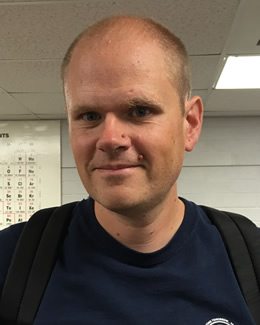
Conor Tyson
Utah State University
Mentors:
Faculty: Ryan Dupont
Near-Peer:
Research Focus:
Research Focus Area 2
Project:
Major:
Environmental Engineering
Biography:
Conor got his first Bachelors degree in history with a microbiology minor from BYU. After working eight years in a microbiology laboratory he decided to return to school and study environmental engineering. He will be a senior at USU next school year and hopes to start a career in the water and wastewater sector. He is married and has two kids aged five and two. He enjoys camping with his family and enjoying the outdoors and enjoys that working at the UWRL involves significant outdoor work.
Research Abstract:
Wastewater treatment plants significantly reduce the microbial load in treated water. However, the remaining microbes may be able to regrow in the nutrient-rich wastewater effluent. Therefore, when this treated effluent is used as a secondary water source on crops, there is a potential for contamination. For this study, an agricultural field was irrigated using treated wastewater from the Hyrum Wastewater plant. All microbial tests were processed using IDEXX’s Colilert and Enterolert. These tests enable MPN counts for coliforms, E. coli, and enterococcus, all found in high levels in wastewater influent. The water was tested before and after irrigation to determine the microbial loads applied to the crops. Plant samples were then taken daily to determine both the initial microbial contamination level and any die-off or regrowth that occurs after the irrigation event.
Weekly Recap:
Week 1 | Week 2 | Week 3 | Week 4 | Week 5 | Week 6 | Week 7 | Week 8 | Week 9 | Week 10 | Week 11
Week 1: May 15-21, 2017
No entry
Week 2: May 22-28, 2017
No entry
Week 3: May 29-June 2, 2017
No entry
Week 4: June 5-9, 2017
No entry
Week 5: June 12-17, 2017
On Monday morning I went out by the landfill to collect groundwater samples for arsenic analysis. It is always fun out in the field, although this trip was very windy and rainy. However, since it was raining I was able to go out with Chase Monday afternoon and all day Tuesday to collect rainwater runoff samples for his project. We got a number of samples that we were able to test using the IDEXX system with all results done by Wednesday. The rest of the week we spent some time getting equipment ready for future rain events.
Also this week I was offered the opportunity to join the iFellows program. After working out details I officially joined and talked with Dr. Dupont about what my specific project will be. I will be looking at microbial levels in a wastewater reuse system. So far we have just worked on setting up a time to go and collect samples, so not much has happened for my project. Still, we do have data on the microbe levels in the wastewater influent and effluent.
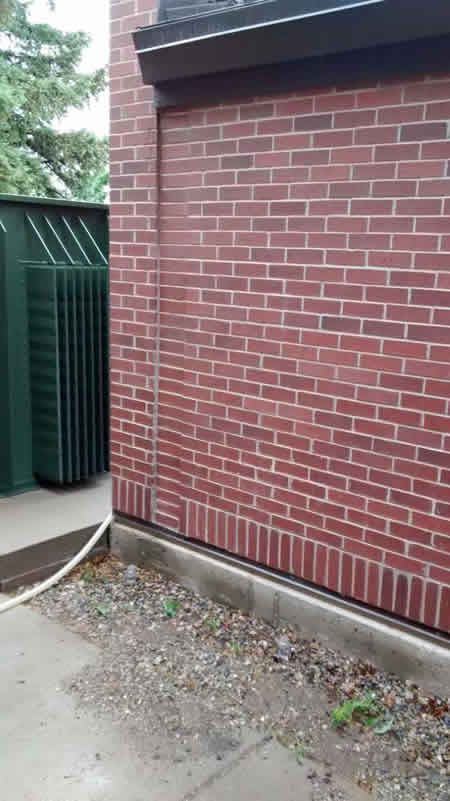
We collected roof runoff samples by placing sample cups in the path of the drip off. A slow but effective method.
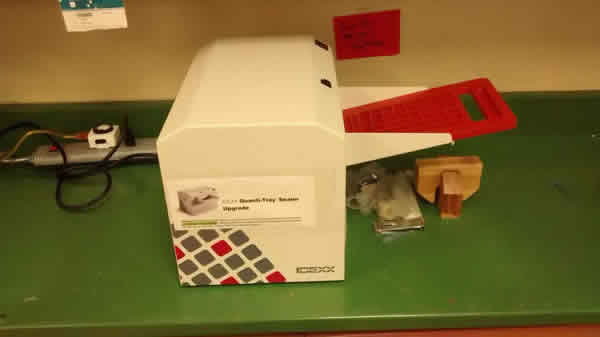
The machine we use to seal all microbial tests done via IDEXX
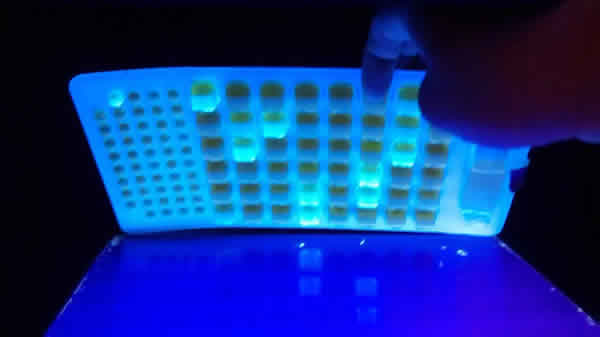
One of the results from the rainwater tests. The wells fluorescing are positive for E. coli. After counting the number of positive wells, an MPN result can be looked up on a chart.
Week 6: June 19-23, 2017
This week I got to go out and get samples for my project. On Wednesday we went to a wastewater plant to get a sample of their effluent, a field irrigated by that effluent for water and plant samples, and a secondary use reservoir to test the sitting water and a canal feeding it. I got on the samples tested that day and read the results Thursday.
Otherwise this week we prepared equipment for collecting rain water and continued maintaining a site where plants are tested on their ability to filter runoff.

Collecting plant samples from a cow pasture to determine if the irrigation water is contaminating plants.
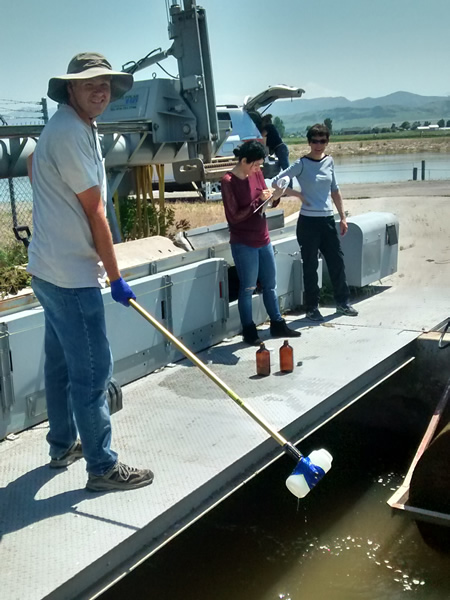
Collecting water samples to compare microbial loads in water sources.
Week 7: June 26-30, 2017
On Monday I again went out to help collect groundwater samples near the landfill. The water table is much lower and the resulting water was dirtier. That afternoon I did biosolid tests for BOD to determine how the BOD machine operates. On Tuesday we had a little bit of rain so I went with Chase to collect what rainfall samples we could and to process them. Despite having only two samples it still took awhile to do all the process. On Thursday we installed more samplers for collecting rainfall. On Friday we went to a site with plants and transplanted lots of sunflowers. Also, we had a meeting and a more detailed description of how we are setting up my project was discussed. We are hopeful we can get it started on Wednesday so I can have data for my poster.
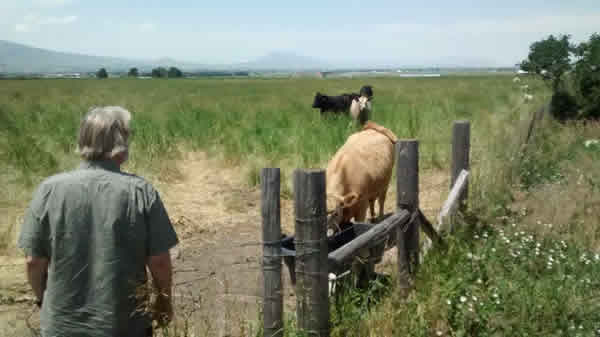
Dr Dupont observing the field where the irrigation study will take place.
Week 8: July 3-7, 2017
This week was very busy. On Monday I met with several professors and others to make sure everything would be ready to start my experiment on Wednesday. I obtained supplies, prepared equipment, and made plans for who would be going with me at various times.
On Wednesday I met with two others at 7am to go out to the field and set up the irrigation sprinkler. We also took water samples, set out collection containers, and set up air monitoring equipment to monitor air particles from the sprinkler. We were out for several hours taking samples, then left with most of the equipment around lunch time. The sprinkler we left running as a 12 hour run was needed. That afternoon I helped Chase simulate a rain event on a roof and prepared more sample containers for me experiment. That evening I went out at 7pm with some others to collect the sprinkler and obtain and process my first plant sample.
Thursday morning I again went to the field to take my second plant sample. After processing it I spent the rest of the day preparing containers to take samples all weekend. I also took measurements of the samples already taken. I read micro results on the water that afternoon, and on my plants at 9pm.
Friday after returning to Logan I again went out to collect more plant samples and process them. I will have to do the same process on Saturday and Sunday in order to get my daily samples for my study.
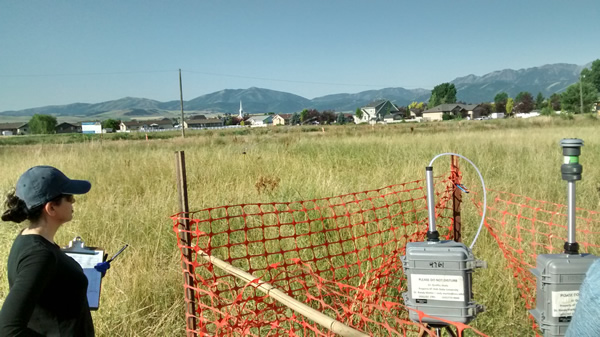
Dr Irrigating the field and monitoring the air sampling equipment with Leila, a postdoc at USU.
Week 9: July 10-14, 2017
On Monday I again helped get water samples near the landfill. In the afternoon I went for my last time to get samples for my project. In the evening I read results from Sunday's samples.
On Tuesday I helped Chase generate a rain event in the morning, then read my final results. This allowed me to make my final changes to my poster. Wednesday I watered plants in a rainwater filtration site. Then helped obtain samples from a wastewater treatment plant for Dr Dupont.

A deer I encountered just outside the water lab
Week 10: July 17-21, 2017
Week 11: July 24-28, 2017
For my final week as an iFellow, my personal project was mostly concluded so I spent the three working days working on other projects. On Tuesday I went to collect groundwater samples in the morning, and rain samples in the afternoon. The rain samples I also helped running for microbial tests. On Thursday I tried to fix the auto-samplers that are set out to collect rain events as they occur. I had some success and returned Friday morning to finish the job. Friday afternoon I went out to a site to weed bio retention bays we planted this summer.
I spent some evenings working on finishing my presentation and my extended abstract. After presenting on Wednesday I was able to finish my abstract with fully updated figures. I then had to re present my presentation on Friday to those who are working on the project as it continues. I feel the iFellow experience helped me become more comfortable researching and presenting the findings. I am glad I had this opportunity this summer.
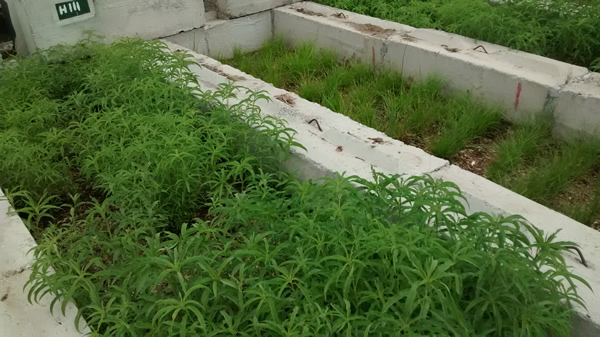
Some of the retention bays I had to weed. These plants were tiny seedlings a few weeks ago.
All content provided on this iUTAH Team - Undergraduate iFellows weekly recap is unedited, updated by each participant to provide a review of their progress, and is for informational purposes only.



